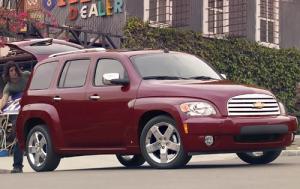- Save |
- Email |
- RSS |
- Newsletter

New Models
-
2011 Chevrolet HHR MSRP from $18,720
 View photos
View photos
Used Models
-
2011 Chevrolet HHR Used TMV from $16,327 Find Used Inventory
 View photos
View photos
-
2010 Chevrolet HHR Used TMV from $13,607 Find Used Inventory
 View photos
View photos
-
2010 Chevrolet HHR SS Used TMV from $20,329 Find Used Inventory
 View photos
View photos
-
2009 Chevrolet HHR Used TMV from $12,069 Find Used Inventory
 View photos
View photos
-
2009 Chevrolet HHR Panel SS Used TMV from $16,740 Find Used Inventory
 View photos
View photos
-
2009 Chevrolet HHR SS Used TMV from $16,723 Find Used Inventory
 View photos
View photos
-
2008 Chevrolet HHR Used TMV from $10,493 Find Used Inventory
 View photos
View photos
-
2008 Chevrolet HHR SS Used TMV from $14,625 Find Used Inventory
 View photos
View photos
-
2007 Chevrolet HHR Used TMV from $8,816 Find Used Inventory
 View photos
View photos
-
2006 Chevrolet HHR Used TMV from $7,706 Find Used Inventory
 View photos
View photos
The Chevrolet HHR was something of a late arrival to the compact wagon scene. Its name stands for "Heritage High Roof," referring to its tall retro-wagon styling, which Chevrolet claims was inspired by the '49 Suburban. Everything else about the vehicle, however, is decidedly modern.
Though compact in size, the Chevy HHR features clever interior packaging solutions, including a split-folding rear seat, a fold-flat front passenger seat and a cargo area floor (with built-in grocery bag hooks) that allows it to accommodate bulky and/or long cargo items. For shoppers searching for a versatile compact wagon that's also stylish, the HHR certainly merits consideration.
Current Chevrolet HHR
The Chevrolet HHR is a compact four-door wagon that shares its front-wheel-drive architecture -- and thus many of its driving characteristics -- with the now-discontinued Chevrolet Cobalt. Three trim levels are offered: LS, 1LT and 2LT. A passenger version is available in all trims, and there's also a two-seat panel van version that comes in LS and LT trims.
The base LS model features full power accessories, cruise control, air-conditioning, keyless entry and a stereo with an auxiliary input jack as standard. The 1LT adds a power driver seat and a longer options list. Both the LS and 1LT are powered by a 155-horsepower, 2.2-liter inline-4, while the 1LT offers the option of a 172-hp 2.4-liter four-cylinder engine. The 2LT includes the bigger engine as well as 17-inch wheels, a firmer suspension and a premium stereo. All HHRs have antilock brakes, stability control and side curtain airbags as standard.
Oddly, all the trims offer roughly the same EPA fuel economy ratings regardless of engine or transmission choice, the latter limited to five-speed manual or four-speed automatic units. The Chevy HHR is available only with front-wheel drive, while several competitors offer all-wheel drive for enhanced foul-weather capability.
The cabin boasts nicely detailed gauges, tight construction and substantial-feeling controls. The HHR's tall ceiling provides headroom aplenty, but the narrow body limits comfort for adults riding in the backseat. In testing, our editors commented favorably about the HHR's smooth and quiet ride, ample cargo space, attractive interior, excellent visibility and versatile sound system. Noted downsides included weak brakes, underwhelming handling dynamics and a lack of refinement from the 2.4-liter engine.
Used Chevrolet HHR Models
The Chevrolet HHR was an all-new model in 2006. Changes have been minor since. The HHR's sophomore year brought a little more power (the 2.2-liter four went from 143 to 149 hp, while the 2.4-liter unit went from 172 to 175 hp. A panel van version debuted later that year. For 2008, stability control finally became available. The next year it became standard, as did antilock brakes and side curtain airbags.
When shopping for a used HHR you might also encounter the SS model. This high-performance HHR came with a turbocharged 2.0-liter, 260-hp four-cylinder engine and offered spirited performance, stronger braking and buttoned-down handling. It was offered from 2008-'10 for the regular HHR and 2008 and '09 for the HHR panel van.
Research Models
Advertisement
New Car Resources
Advertisement
Advertisement
Recently Viewed